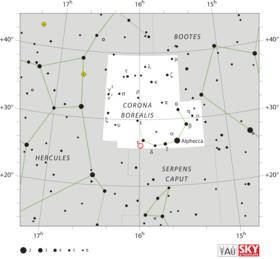| Observation data Epoch J2000 Equinox J2000 | |
|---|---|
| Constellation | Corona Borealis |
| Right ascension | 15h 59m 30.1622s[1] |
| Declination | +25° 55′ 12.613″[1] |
| Apparent magnitude (V) | 2.0–10.8[2] |
| Characteristics | |
| Evolutionary stage | Red giant + white dwarf |
| Spectral type | M3III+p[3] |
| Variable type | recurrent nova[2] |
| Astrometry | |
| Radial velocity (Rv) | −27.79[4] km/s |
| Proper motion (μ) | RA: −4.461 mas/yr[1] Dec.: 12.016 mas/yr[1] |
| Parallax (π) | 1.0920 ± 0.0275 mas[1] |
| Distance | 2,990 ± 80 ly (920 ± 20 pc) |
| Orbit | |
| Period (P) | 227.55 d[5] |
| Semi-major axis (a) | 0.54 AU[6] |
| Eccentricity (e) | 0.0[5] |
| Inclination (i) | 67[7]° |
| Details | |
| Red giant | |
| Mass | 1.12[6] M☉ |
| Radius | 75[7] R☉ |
| Luminosity | 655[8] L☉ |
| Surface gravity (log g) | 2.0[9] cgs |
| Temperature | 3,600[9] K |
| White dwarf | |
| Mass | 1.37[6] M☉ |
| Luminosity | ~100[7] L☉ |
| Other designations | |
| Database references | |
| SIMBAD | data |
T Coronae Borealis (T CrB), nicknamed the Blaze Star, is a binary star and a recurrent nova about 3,000 light-years away in the constellation Corona Borealis.[11] It was first discovered in outburst in 1866 by John Birmingham,[12] though it had been observed earlier as a 10th magnitude star.[13] It may have been observed in 1217 and in 1787 as well.[14][15]
- ^ a b c d Cite error: The named reference
GaiaDR3was invoked but never defined (see the help page). - ^ a b Cite error: The named reference
gcvswas invoked but never defined (see the help page). - ^ Cite error: The named reference
orbitwas invoked but never defined (see the help page). - ^ a b Cite error: The named reference
fekelwas invoked but never defined (see the help page). - ^ a b c Cite error: The named reference
linfordwas invoked but never defined (see the help page). - ^ a b c Cite error: The named reference
stanishevwas invoked but never defined (see the help page). - ^ Cite error: The named reference
schaeferwas invoked but never defined (see the help page). - ^ a b Cite error: The named reference
wallersteinwas invoked but never defined (see the help page). - ^ Starrfield, Sumner; Bose, Maitrayee; Woodward, Charles E.; Perron, Isabelle; Shaw, Gargi; Evans, Aneurin; Iliadis, Christian; Hix, W. Raphael (2024-06-01). "The evolution leading to a thermonuclear runaway". Bulletin of the American Astronomical Society. 56 (7): 132.01. Bibcode:2024AAS...24413201S.
- ^ Andrews, Robin George (8 March 2024). "The Night Sky Will Soon Get 'a New Star.' Here's How to See It. - A nova named T Coronae Borealis lit up the night about 80 years ago, and astronomers say it's expected to put on another show in the coming months". The New York Times. Archived from the original on 8 March 2024. Retrieved 9 March 2024.
- ^ Pettit, Edison (1946). "The Light-Curves of T Coronae Borealis". Publications of the Astronomical Society of the Pacific. 58 (341): 153. Bibcode:1946PASP...58..153P. doi:10.1086/125797.
- ^ Barnard, E. E. (1907). "Nova T Coronae of 1866". Astrophysical Journal. 25: 279. Bibcode:1907ApJ....25..279B. doi:10.1086/141446.
- ^ Schaefer, Bradley E. (16 November 2023). "The recurrent nova T CrB had prior eruptions observed near December 1787 and October 1217 AD". Journal for the History of Astronomy. 54 (4): 436–455. arXiv:2308.13668. Bibcode:2023JHA....54..436S. doi:10.1177/00218286231200492. ISSN 0021-8286.
- ^ Thompson, Joanna (September 15, 2023). "Evidence of mysterious 'recurring nova' that could reappear in 2024 found in medieval manuscript from 1217". Live Science. Retrieved 2024-03-21.
